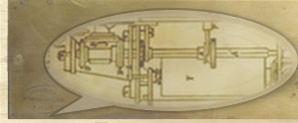 |
 |
 |
 |
 |
 |
|||||||
 |
 |
 |
 |
 |
 |
|||||||
|
|||||||||||||||||||||||||||||||||||||||
| ◄ | |||||||||||||||||||||||||||||||||||||||
Carriage locking mechanism |
* Translation by Eric Schurmann I) Carriage locking mechanism (1852) This extract from the 1865 Patent, summarises perfectly the advantages and disadvantages of the hook that was used on the 1852 machines: "In the old machines (T1850), the carryover worked by means of a double inclined steel plane, fixed to the dial, which pressed against the carryover lever and disengaged it so that it descended vertically. But it so happened that, if several inclined planes were pressing on the carryover levers of several dials at the same time, the levers, instead of descending, made the mobile carriage lift up. This weakened the meshing between the bevel wheels and the dials so that the dials showed false results. Thomas very quickly put in place a new, and more reliable, carryover system but that's another story….
|
||||||||||||||||||||||||||||||||||||||||||
www.arithmometre.org
2013